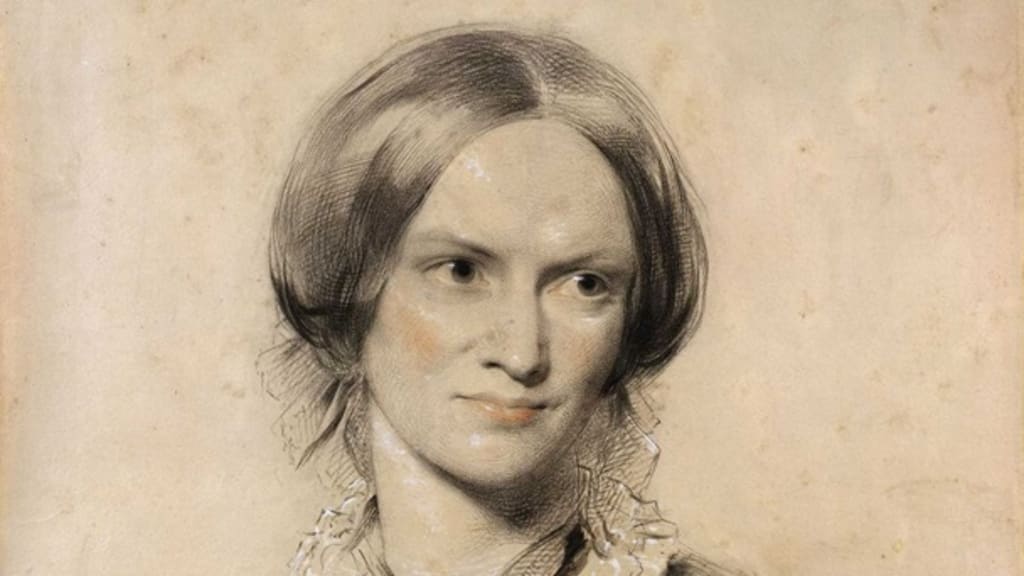'Jane Eyre' by Charlotte Bronte
Part 1: Context and Summary

In 1852, the Literature Critic, George Henry Lewis, is sitting in his office and held spellbound by a work of semi-fiction by a man called Mr. C. Bell. He writes a lengthy piece of an article about it in The Quarterly Review and calls the book a "reality...a deep and significant reality." But who knew that this book was not actually written by Mr. C. Bell at all...?
Let me give you some context of the time.
When a young girl begins writing a book in a Manchester Inn; it is the rise of 1840s. The revolution has recently ended in France, the Paris Uprising has died and war is coming to a close all over Europe. People and places are growing into urban cities and separating themselves from the previous, more idyllic landscapes. Lamentations and progressive articles rise from this as the industrial revolution is about to begin; the steam train is invented and Thomas Edison was probably just finishing school and having his own light-bulb of an idea. Mary Shelley has just revised Frankenstein, Lord Byron and John Keats have recently died and we are witnessing the death of Romanticism altogether. It is the birth of the gothic novel and the domestic gothic era.
In 1847, on the October 16; after about six years of toiling over the text, the book the young girl writes, sets to become one of the best-selling domestic gothic novels of all time. Her name is Charlotte Bronte and the books name is Jane Eyre. It was originally titled: Jane Eyre: An Autobiography. The piece is dedicated to William Makepeace Thackeray, a man who urged Charlotte to publish and probably the only person who knew the book was written by a woman besides Charlotte and her family. He also authored Vanity Fair, a novel regarding young and intelligent women who publishes books and magazines. The Quarterly Review of 1903 even packed Jane Eyre alongside Vanity Fair in the quality of literature—speaking of its raw nature in the "coarseness of language" and its "laxity of morals"—a work of truth and inspiration. Whereas, when it was found out that she was a woman; The Economist of the same year, denounced the book as 'odious' and wrong—as a woman should not write such things; they had the same views on Shelley's Frankenstein—initially published anonymously.
As it is known, Bronte was also good friends with another female writer named Elizabeth Gaskell; author of North and South. Both wrote the bildungsroman text and both were writing under pseudonyms at the time. After Bronte suddenly died, Gaskell publishes a book entitled The Life of Charlotte Bronte and reveals her alter ego "Curer Bell" upon the world. Thus ending the question first posed by the Westminster Review in January 1852: "Who is Curer Bell?" and called the Bronte book of poetry "unimportant" and "falling flat"—but giving Jane Eyre ultimate levels of praise and fanciful language by it "suddenly taking the world by storm."
On the other hand, some of the public did not receive it well. Mothers of aristocratic daughters wrote to Sharpe's London Magazine of Entertainment in the January of 1855 and stated that "no woman under the age of thirty should open it." They stated it contained "wicked oaths" and "unceremonious acts"—such as swearing on God and smoking tobacco.
A semi-autobiographical bildungsroman of a young girl living an unhappy and unstable life; barely getting by and hoping to achieve some spiritual growth by the end of it all.
Initially, Charlotte and her sisters had to use pseudonyms as large-scale publishers did not yet permit female authorship. Their names respectably were Acton, Ellis and Curer Bell. All of which matched up to their initials. Charlotte Bronte had published works on poetry; novels such as Vilette and other works also supporting her sisters and brother. But Jane Eyre would prove to surpass them all; only outdone in sales by her sister's domestic gothic novel Wuthering Heights.
Be that as it may, the Bookman's Table newspaper of November 1899 recounts criticism on the novel regarding the "Celtic temperament" and notes that not many sources written on the text at the time give much account of Bronte or the text itself; but rather concentrate too much on the aesthetics of the binding—since the book is written by a person of middle birth. But, later on—more critics ask to analyse the text and refer to Bronte through Gaskell's text on her life; especially those published in the Saturday Review of Politics, Literature, Science and Art during the early turn of the 20th century.
Let us have a quick glance over the plot of the novel.
Jane Eyre is about a young woman born into a household that has abandoned her with misfortune. She begins her story by explaining that she lives with a woman called Mrs. Reed (her aunt by marriage) and that her uncle, mother and father are either missing or dead. She describes the children of the household as being particularly despicable; John, Georgiana and Eliza. After living at their residence titled "Gateshead" for a time; she moves to Lowood School—a convent school for plain girls.
After which, she becomes shames for her disobedience and resorts into working at the school long after she leaves because of the easiness of lifestyle. With an eye for looking to elsewhere for the sake of her surroundings; she takes up a job in Thornfield Hall as a governess for the young child, Adele Varens. When arriving upon Thornfield Hall, she gets to know little about the man that lives there as well; even though she seems to be smitten by him—his name is Mr. Rochester.
She finds out that Mr. Rochester is due to be married to Blanche Ingram and sees herself as inferior to this woman, but Rochester does not marry. She begins to hope and ends up falling in love with Rochester after saving him from a house-fire that she initially thought was created by the lonesome and mysterious Grace Poole—a servant in the household. She is later due to marry Rochester and then she doesn't.
Mr. Rochester seems to be already married to a woman named Bertha Mason; a very famous character in the classics as she is from the Caribbean Islands. Jane is angered and runs away from Thornfield to live with St. John Rivers and his two sisters. After realising that St. John is falling in love with her; she aptly leaves and heads back to Thornfield—where she witnesses another fire. This time, to the entire house. Bertha went mad, set the house on fire and locked herself in—killing herself. Mr. Rochester is now deaf and blind - and Jane states in the final chapter; Reader, I married him.
Contextually, this book was written to reflect Charlotte Bronte's own hardship growing up; she was poor and so were her sisters. Only their father bothered to read them stories and the three girls were sent to a rotten boarding school that is written as "Lowood" in the novel. Various landmarks in places such as Manchester and York were made to represent factors of Gateshead and Thornfield respectably.
The themes of the novel include: morality, social class, marriage, education, gender, homeliness, family and powerlessness. Each theme holds particular importance to Jane herself as she is directly changed by all of them; the only character to suffer at the hand of each except for Bertha Mason.
With a wide range of characters including Jane herself, the Reed family, Rochester, Bertha, Blanche, Adele, Bessie, St. John etc. There is understanding as to why it took Bronte a long time to write and why it is still so famous today.
The understanding of the novel has reached from Gilbert and Gubar's Madwoman in the Attic all the way down to Christian Theology and the Supernatural. Today's seminar will regard the building of Jane's identity as we work through the understandings of different times in Jane's life and different interpretations both from after 1900 and during Bronte's lifetime.
Bronte was both well-received and ill-received by the public; naturally the lower-middle class respected her more than the higher-middle class and she developed a cultural following of women who were writing similar books: her sister Emily Bronte, Emily Dickinson and the likes of Christina Rossetti and the female Pre-Raphaelite poets. Unfortunately, six months after giving birth—on March 31, 1855—Charlotte Bronte died of consumption. She died in her sleep survived by her only child. She was 38.
Part two will be covering the identity politics that draw us to Jane and her character in this bildungsroman classic and how exactly she reaches her ultimate goal—though we may not know exactly what that is.
About the Creator
Annie Kapur
200K+ Reads on Vocal.
English Lecturer
🎓Literature & Writing (B.A)
🎓Film & Writing (M.A)
🎓Secondary English Education (PgDipEd) (QTS)
📍Birmingham, UK






Comments
There are no comments for this story
Be the first to respond and start the conversation.